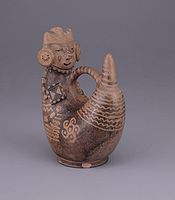
Virú culture
Encyclopedia

Virú
Virú is a town in Northern Peru, capital of the province Virú in the region La Libertad.-References:...
in La Libertad Region
La Libertad Region
La Libertad is a region in northwestern Peru. Formerly it was known as the 'Department of La Libertad" , a political division that generally corresponds to a state in the United States of America...
of Peru
Peru
Peru , officially the Republic of Peru , is a country in western South America. It is bordered on the north by Ecuador and Colombia, on the east by Brazil, on the southeast by Bolivia, on the south by Chile, and on the west by the Pacific Ocean....
from 100 to 300 CE. The center of their culture was "Castillo de Tomabal", on the left bank of the river Virú.
The Virú culture was conquered by the Moche
Moche
'The Moche civilization flourished in northern Peru from about 100 AD to 800 AD, during the Regional Development Epoch. While this issue is the subject of some debate, many scholars contend that the Moche were not politically organized as a monolithic empire or state...
s from the Cuenca of the Chicama, about the 1st century CE. Two hundred years later they were driven from the banks of the Virú.
Description
The Virú culture erected large adobeAdobe
Adobe is a natural building material made from sand, clay, water, and some kind of fibrous or organic material , which the builders shape into bricks using frames and dry in the sun. Adobe buildings are similar to cob and mudbrick buildings. Adobe structures are extremely durable, and account for...
buildings, including at San Juan, Napo, Sarraque, and Tomabal. The Virú were the initiators of the huacos (portrait ceramics), a technique which years later would be perfected by the Moche.
They had a class-based society. As in all the cultures of these times, agriculture was the base of the economy. In the valleys of Chicama, Moche, and Virú, large irrigation projects extended the limits of agriculture. Principal crops cultivated were corn, beans, legumes, cassava
Cassava
Cassava , also called yuca or manioc, a woody shrub of the Euphorbiaceae native to South America, is extensively cultivated as an annual crop in tropical and subtropical regions for its edible starchy tuberous root, a major source of carbohydrates...
, cotton, green pepper, Lúcuma
Lúcuma
The lúcuma is a subtropical fruit native to the Peru's Andean region. Lucuma has been found on ceramics at burial sites of the indigenous people of coastal Peru...
, and other fruit trees. These crops were supplemented by trade in dried fish and seafood products, which were obtained from other coastal Andean peoples.
The culture had a rich history of art. They used a negative painting technique. Many pieces can be seen in the Larco Museum
Larco Museum
The Larco Museum is a privately owned museum of pre-Columbian art, located in the Pueblo Libre District of Lima, Peru. The museum is housed in an 18th century vice-royal mansion built over a 7th century pre-Columbian pyramid. It showcases chronological galleries that provide a thorough overview of...
Collection in Lima
Lima
Lima is the capital and the largest city of Peru. It is located in the valleys of the Chillón, Rímac and Lurín rivers, in the central part of the country, on a desert coast overlooking the Pacific Ocean. Together with the seaport of Callao, it forms a contiguous urban area known as the Lima...
, Peru.

